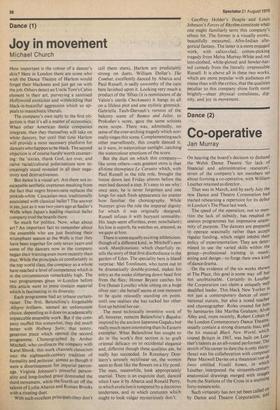Dance (1)
Joy in movement
Michael Church
How important is the colour of a dancer's skin ? Here in London there are some who wish the Dance Theatre of Harlem would forget their blackness and just get on with the job. Others detect an Uncle Tom's Cabin element in their art, purveying a sanitised Hollywood exoticism and withholding that black-is-beautiful aggression which so appeals to masochistic liberals.
The company's own reply to the first objection is that it's all a matter of economics. When other American dance companies integrate, then they themselves will take on white dancers, but until that time Harlem will provide a most necessary platform for dancers who happen to be black. The second objection is of course hardly worth countering: the 'sixties, thank God, are over, and naive racial/cultural polarisations now increasingly stand revealed in all their negativity and destructiveness.
But dance is a visual art. Are there not inescapable aesthetic overtones resulting from the fact that negro brown-ness replaces the pinkish-white Caucasian-ness .traditionally associated with classical ballet? The answer is yes. just as it was two years ago at Sadler's Wells when Japan's leading classical ballet company trod the boards there.
So much for politics. Now, what about art ? An important fact to remember about the ensemble who are just finishing their triumphant season at the Wells is that they have been together for only seven years and some of the dancers now in the company began their training even more recently than that. While the principals sit comfortably in the top world class, the company as a whole have reached a level of competence which is in the circumstances remarkably high. The two programmes given in London before this article went to press contain material which is fascinating in its diversity.
Each programme had an urbane curtainraiser. The first, Balanchine's forgettable Allegro brillante, seemed an unfortunate choice, depending as it does on academically impeccable ensemble work. But if the company muffed this somewhat, they did much better with Ho/berg Suite, that sunny, generous piece which opened the second programme. Choreographed by Arthur Mitchell, who co-directs the company with Karel Shook, this work channels classicism into the eighteenth-century tradition of formality and politesse, almost as though it were a divertissement for imperial patronage. Virginia Johnson's powerful personality and long-limbed grace dominated the third movement, while the fourth set off the talents of Lydia Abarca and Roman Brooks with a riveting duet.
With such excellent principals (they don't
call them stars), Harlem are predictably strong on duets. William Dollar's The Combat, excellently danced by Abarca and Paul Russell, is sadly unworthy of the care here lavished upon it. Looking very much a product of the 'fifties (it is reminiscent of de Valois's sterile Checkmate) it hangs its all on a lifeless plot and one stylistic gimmick. Gabriella Taub-Darvash's version of the balcony scene of Romeo and Juliet, to Prokofiev's score, gave the same soloists more scope. There was, admittedly, no sense of the over-arching tragedy which normally tinges this scene. Complementing each other marvellously, this couple danced it, as it were, in watercolour sunlight, catching the watercolour emotions of the score.
But the duet on which this company— like some others—sets greatest store is that all-time showpiece Le Corsaire which, with Paul Russell in the title role, brought the house down last Friday almost before the man had danced a step. It's easy to see why: once seen, he is never forgotten and one longs for each fresh appearance no matter how familiar the choreography. While Nureyev gives the role the imperial dignity for which it was originally designed. Russell infuses it with buoyant sensuality. His leaps seem effortless, even nonchalant: his line is superb, he watches us, amused, as we gape at him.
There is some equally exciting athleticism, though of a different kind, in Mitchell's new work Manifestations, which cheerfully retells the story of that first disobedience in the garden of Eden. The speciality here is bland surprise: Mel Tomlinson, who turns out to be dramatically double-jointed, makes his entry as the snake slithering down head first from the flies; Homer Bryant catches his Eve (Susan Lovelle) while sitting on a huge silver star; she herself seems at one moment to be quite relaxedly standing on point, until one realises she has tucked her other foot up behind her ear.
The most technically inventive work of all, however, remains Balanchine's Bugaktt, inspired by the ancient Japanese-Gagaku but really much more interesting than its Eastern exemplar. What Balanchine has sought to do in the work's first section is to graft oriental delicacy on to occidental elegance and, different though these qualities are, he really has succeeded. In Rosemary Donleavy's serenely rectilinear set, the women seem to float like the flowers on a lily pond. The men, meanwhile, look appropriately martial. There is an exquisite duet, danced when I saw it by Abarca and Ronald Perry, in which eroticism is tempered by a decorous tenderness, and in which costumes which ought to look vulgar mysteriously don't. Geoffrey Holder's Dougla and Louis Johnson's Forces of Rhythm constitute what one might familiarly term this company's ethnic bit. The former is a visually exotic, beautifully measured, Afro-Indian allegorical fantasy. The latter is a more engaged work, with calico-clad, cotton-picking tragedy from Melva Murray-White and red loin-clothed, white-gloved and bowler-hatted comedy from the literally irrepressible Russell. It is above all in these two works, which are more popular with audiences en masse than with the critics, that the qualities peculiar to this company shine forth most brightly—sheer physical comeliness, dignity, and joy in movement.


































 Previous page
Previous page